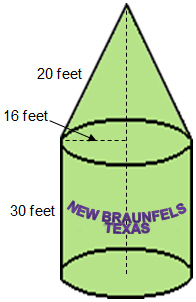Finding the total surface area of a composite figure is similar to finding the surface area of 3-dimensional figures such as prisms, cylinders, pyramids, cones, and spheres. These shapes are combined to make 3-dimensional figures called composites figures .
![]()
Source: Surface Area of Composite Figures (Prisms), TenMarksInstructor, You Tube

The figure at right represents the water tower for a town in Texas. It is a composite of a cylinder and a cone . The city council has decided to repaint the entire outer surface of the water tower.
Determine the surface area that will be painted.
Identify the Interactive popup. Assistance may be required.
The base of the cone and the top base of the cylinder

Lateral Area of
LA = πrl
≈ 3.14(16 feet)(20 feet)
≈ 1005 ft2

Lateral Area of
LA = 2πrh
≈ (2)3.14(16 feet)(30 feet)
≈ 3,016 ft2

Area of Base of
A = πr2
≈ 3.14(16 feet)2
≈ 804 ft2

Total
SA = LAcone + LAcylinder + Abase
≈ 1005 ft2 + 3016 ft2 + 804 ft2
≈ 4825 ft2

Anytime the surface area of a composite figure is found, ask if the top or bottom is open or the connection of the two shapes. If there is an opening or a common side, only the areas of the enclosed sides or non-common sides are found.